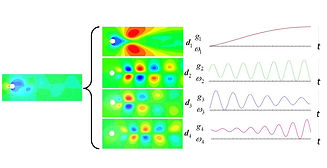Bridging data-driven modeling and CFD
Reduced-order modeling of unsteady aerodynamics based on nonlinear system identification
Any static and dynamic system can be treat as a 'block box', which means that the intrinsic mechanism of such system is unknown to us, and only the input-output data pairs are available. Through system identification methodology, a low-dimensional abstractions of such system with dominant system characteristics can be constructed. Based on system identification strategy, we have developed some nonlinear reduced-order models for unsteady, nonlinear aerodynamics, using only the input (structure displacement) and output (aerodynamic loads) data. (more information)


Hybrid reduced-order modeling framework for linear and nonlinear aerodynamics
Even though system identification (including linear and nonlinear methods) has been introduced to model unsteady flow dynamics, this strategy is limited because the pure nonlinear model cannot identify the linear dynamics accurately, and the linear model cannot describe the intrinsic nonlinear aerodynamic features. Therefore, we have proposed several hybrid modeling structure incorporating both linear and nonlinear models and applied such models to reduced-order modeling of aerodynamic and aeroelastic systems. (more information)
Flow characteristic extraction through mode decomposition techniques
In experiments or numerical simulations of fluid flows, we encounter a hugh amount of data and cannot analyze what characterizes the flow dynamics. However, in fact, the evolution and behaviors of such high-dimensional, complex and mass quantities are determined by several dominant coherent structures. Mode decomposition techniques provide a tool to extract such main features and retain the intrinsic dynamics through a much smaller number of orders. The extracted flow patterns are also good visualization of the fluid physics. We utilize these approaches for analysis and model order reduction of complex flow fields. (more information)

